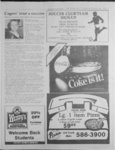| OCR Text |
Show THE THUNDERBIRD PAGE 32 TUESDAY, SEPTEMBF u .r- - . Sports 1 Outdoors" & Eligibility no easy task for collegiate athletes f J $ k BY WENDY BENTON 4 C. I 'ucy::; n wy X1 ''" '"' Jl to V --i ; VfV v' 5 . w TU t W iV V t t( Lora Woolston, a freshman English major from South Jordan, . . i s . TTh h A A v A ? ' 't is ' I.?-- ( ' 4 i . - S' ? v'tV-v'V- "' I n ' , f- - A ''vv . ' s? aV irV; i. s . I YV.f : w js i Most students have their hands full with classes and finishing college in four years. But for collegiate athletes, the task is not only classes and graduating, but maintaining the academic standards set by the NCAA in order to be able to compete. ' V' O 'V , v f X'" one of five women cross country runners. Thinclads are thin in numbers BY KATHLEEN PETT Strength in numbers may apply to a batallion, but the SUSC cross country team couldnt fill a jeep. If they could, they would probably fight over who gets to sit in front. And even though a team as small as this years squad could be a r coach Bill Evans has refused detriment, to let numbers be a negative factor. Instead he has decided to focus on making first-yea- each individual performance count, knowing that the margin of error is slight. (A small team) leaves us no room for sub-pa- r performances since five scores count at each meet, said Evans. Typically a team has six or seven entrants in a meet from which to record the top five scores. In SUs case, however, the mens team consists of six members; five compete for the women. Evans theory paid off in the opener at the .uxi--. STU M i 1 1 ljj it i ( ' (AV ' (- - Stags k&sue -- 1 il Whittier Invitational Sept. 15. The women turned in a fifth place show'ing in the finish. field, led by Mary Gribbles eighth-plac- e The men were eighth of the 16 teams, led by good performances from freshman Gary Hamblin and senior Greg Collins, according to Evans. Combining the totals for the men and women, SUSC brought back a sixth place. Saturday the teams were again on the road, traveling to Provo to compete in the annual BYU Invitational. The mens squad finished last behind Colorado State and the host Cougars. Hamblin finished highest for the men in 29th, and Travis Willson was close behind in 31st. The women finished second to BYU, as Gribble was ninth. Cedar City is the site for the teams next meet, the SU Invitational, on Oct. 6. (The teams) have been working under a defined training program during the summer, so they should be ready for the (remainder of the) season, said Evans. To maintain scholarships and meet these NCAA standards, student athletes must balance a successful academic career with an already active athletic schedule. Having this responsibility creates an extra challenge to find a proper balance. Every incoming student athlete must meet standards set by the NCAA, the governing body of college athletic participation. Proposition 48 states that student athletes must have 1 1 high school core academic credits, a consistent 2.0 grade point average, and an ACT score of at least 18 or an SAT score of at least 700. These standards must be met before an athlete can even begin an athletic career at college. If they are not met, then he or she is forced to concentrate on academic requirements for a period of one year. The first two years of college are spent fulfulling general education requirements. Each athlete must pass 12 credit hours each quarter, and 36 hours for the entire year. As juniors, students must pick a major offered and show satisfactory progress in that area. Studentathletes have five years in which to use up four years of eligibility. Many athletes are fifth year students, said Dave Braegger, faculty athletic representative. They are one year, which means they can practice but not compete. Many will graduate above average. Many come back and assist as coaching staff so they can get their degree, he said. To date, SUSC has not been charged with violating any NCAA academic eligibility rules. However, Braegger said mistakes can be made. With the number of students going through the program, it is very easy for a person not paying attention to make a clerical error. This is the reason for the Compliance Committee, a system of checking for clerical errors. It minimizes clerical errors and premeditation (of breaking NCAA rules) is stopped. It is a fairly good system, said Braegger. The NCAA has penalized schools which fail to comply with the regulations. The famed death penalty, eliminating an entire athletic program from a schools offerings as with n Southern Methodist University, or prohibiting games as with Oklahoma, can result from blatant violations. When it comes to specific graduation rates, according to Braegger, SUSC student athletes graduate at a higher rate than the rest of the student body percentage-wise- . red-shirt- post-seaso- |







































